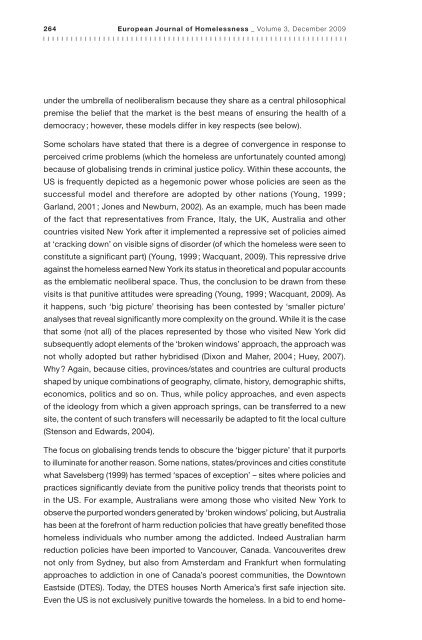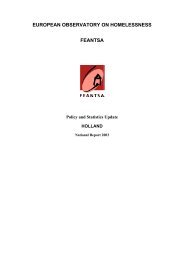Part A - Feantsa - Horus
Part A - Feantsa - Horus
Part A - Feantsa - Horus
Create successful ePaper yourself
Turn your PDF publications into a flip-book with our unique Google optimized e-Paper software.
264 European Journal of Homelessness _ Volume 3, December 2009<br />
under the umbrella of neoliberalism because they share as a central philosophical<br />
premise the belief that the market is the best means of ensuring the health of a<br />
democracy ; however, these models differ in key respects (see below).<br />
Some scholars have stated that there is a degree of convergence in response to<br />
perceived crime problems (which the homeless are unfortunately counted among)<br />
because of globalising trends in criminal justice policy. Within these accounts, the<br />
US is frequently depicted as a hegemonic power whose policies are seen as the<br />
successful model and therefore are adopted by other nations (Young, 1999 ;<br />
Garland, 2001 ; Jones and Newburn, 2002). As an example, much has been made<br />
of the fact that representatives from France, Italy, the UK, Australia and other<br />
countries visited New York after it implemented a repressive set of policies aimed<br />
at ‘cracking down’ on visible signs of disorder (of which the homeless were seen to<br />
constitute a significant part) (Young, 1999 ; Wacquant, 2009). This repressive drive<br />
against the homeless earned New York its status in theoretical and popular accounts<br />
as the emblematic neoliberal space. Thus, the conclusion to be drawn from these<br />
visits is that punitive attitudes were spreading (Young, 1999 ; Wacquant, 2009). As<br />
it happens, such ‘big picture’ theorising has been contested by ‘smaller picture’<br />
analyses that reveal significantly more complexity on the ground. While it is the case<br />
that some (not all) of the places represented by those who visited New York did<br />
subsequently adopt elements of the ‘broken windows’ approach, the approach was<br />
not wholly adopted but rather hybridised (Dixon and Maher, 2004 ; Huey, 2007).<br />
Why ? Again, because cities, provinces/states and countries are cultural products<br />
shaped by unique combinations of geography, climate, history, demographic shifts,<br />
economics, politics and so on. Thus, while policy approaches, and even aspects<br />
of the ideology from which a given approach springs, can be transferred to a new<br />
site, the content of such transfers will necessarily be adapted to fit the local culture<br />
(Stenson and Edwards, 2004).<br />
The focus on globalising trends tends to obscure the ‘bigger picture’ that it purports<br />
to illuminate for another reason. Some nations, states/provinces and cities constitute<br />
what Savelsberg (1999) has termed ‘spaces of exception’ – sites where policies and<br />
practices significantly deviate from the punitive policy trends that theorists point to<br />
in the US. For example, Australians were among those who visited New York to<br />
observe the purported wonders generated by ‘broken windows’ policing, but Australia<br />
has been at the forefront of harm reduction policies that have greatly benefited those<br />
homeless individuals who number among the addicted. Indeed Australian harm<br />
reduction policies have been imported to Vancouver, Canada. Vancouverites drew<br />
not only from Sydney, but also from Amsterdam and Frankfurt when formulating<br />
approaches to addiction in one of Canada’s poorest communities, the Downtown<br />
Eastside (DTES). Today, the DTES houses North America’s first safe injection site.<br />
Even the US is not exclusively punitive towards the homeless. In a bid to end home-




